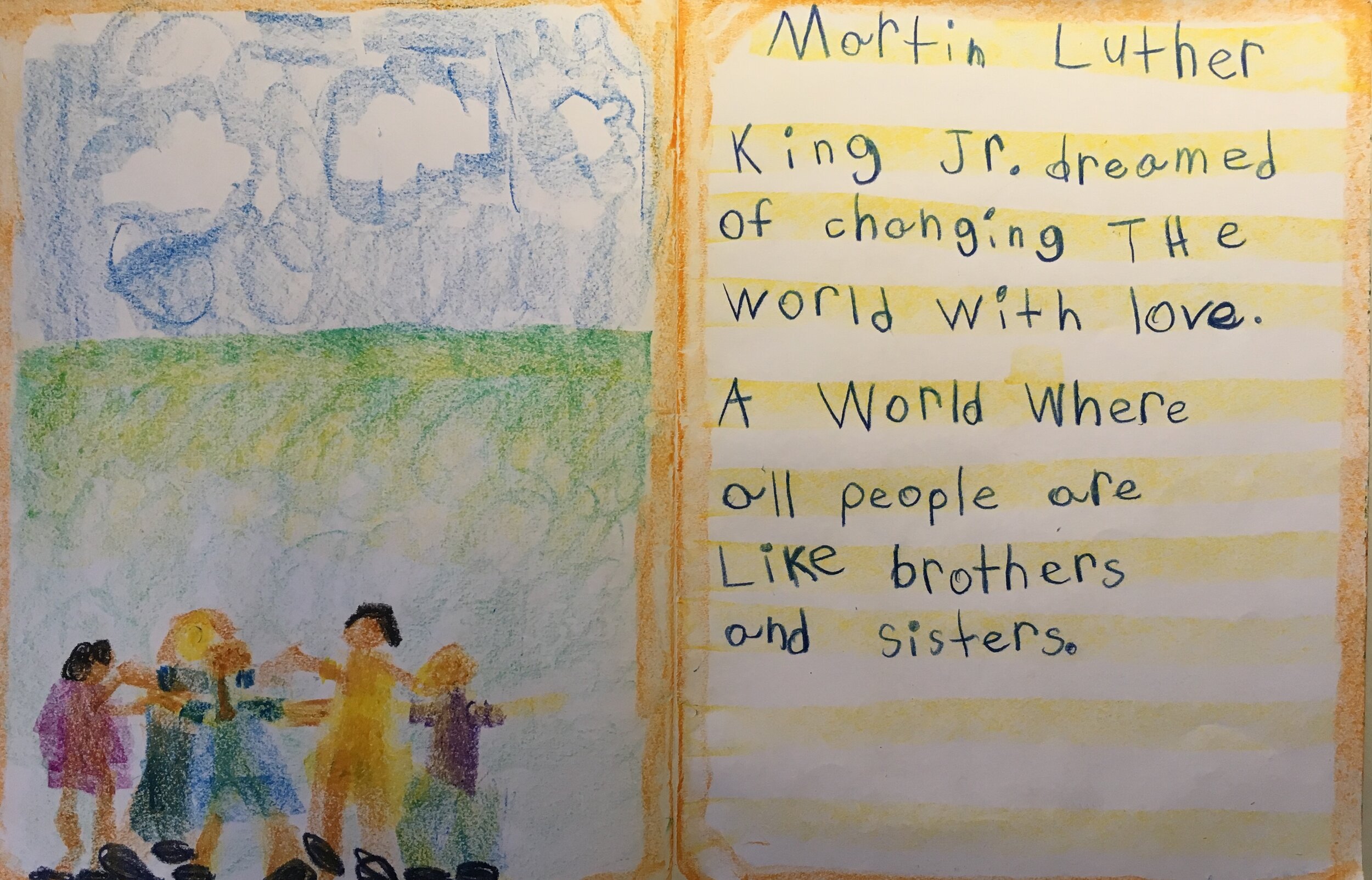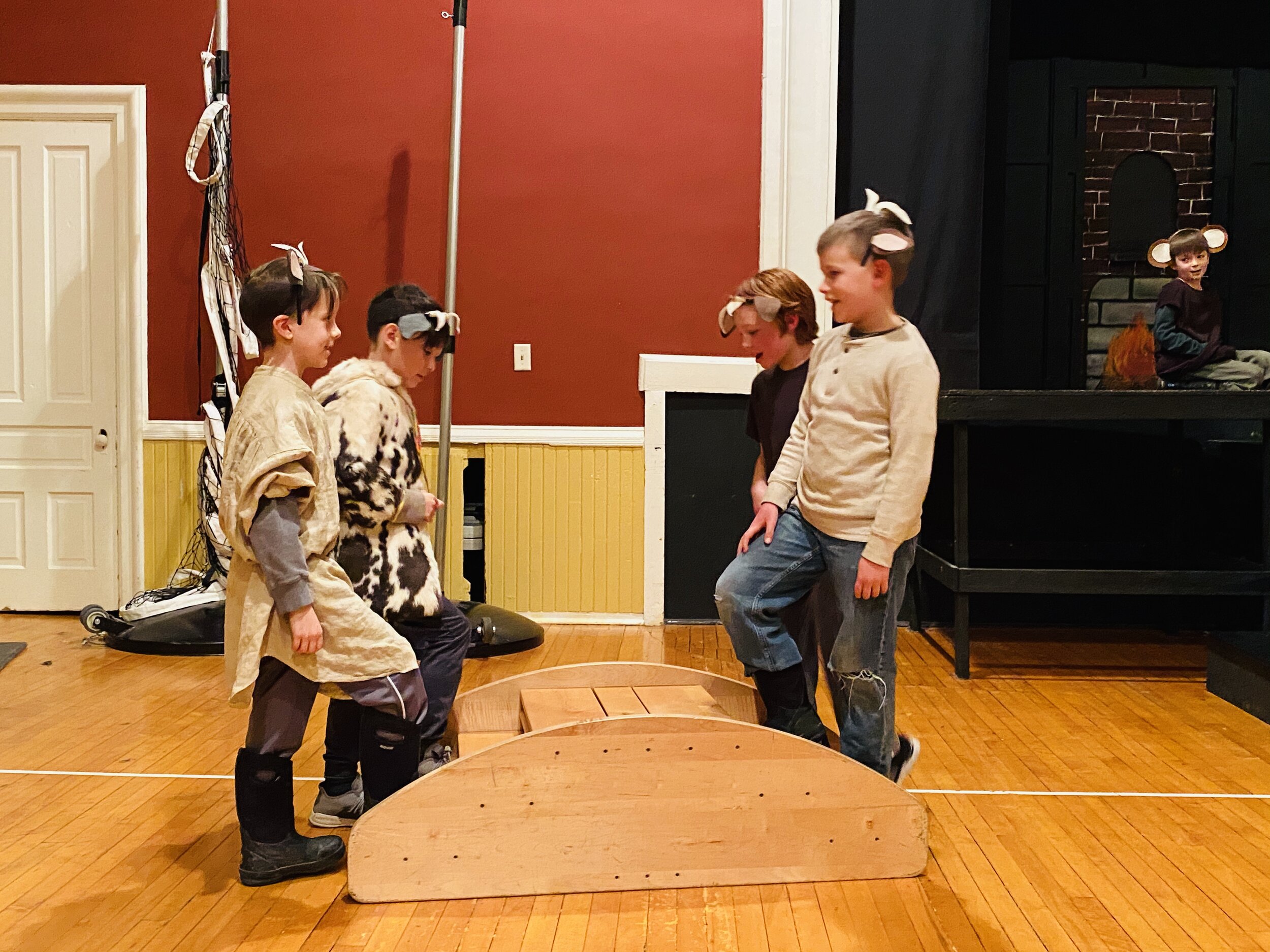Grade 2
GRADE TWO CURRICULUM OVERVIEW
This overview is from the 2019-2020 school year.
“The importance is not to transmit information but to utilize knowledge to develop human capacities.” -Rudolf Steiner
The second grader is now ready for new challenges and a deeper, more challenging curriculum. They have done much growing over the summer, physically and mentally, so they are ready for bigger challenges, intellectually and emotionally. These new challenges are met with enthusiasm as children “stretch their wings and learn to fly”. The curriculum becomes more rigorous in terms of writing, reading what’s been written, and reading aloud from books. Arithmetic is done using all four operations (addition, subtraction, multiplication, and division) and problems are still written horizontally.
While the main goal in grade one is to bring form to the class and to make it cohesive, a grade two class may reflect a mood of contrast or polarization. This might be seen in the way that the students relate to each other. One might experience a split, boy from girl, or group from group. Teaching fables and stories or legends of heroic and courageous people helps meet the dualistic nature of the second grader.
In second grade students are encouraged to write more independently for the first time, using a whole language approach, with first attempts written phonetically, and focus on transforming words to “official” spellings brought gradually, as children begin to learn to edit their work.
Running forms are brought in Form Drawing, to prepare the child for an introduction to cursive writing brought later in the year, with the intent to write exclusively in cursive in third grade. Cursive writing (curved line, which has to do with feeling) provides a good balance for manuscript (printed writing), which has to do with thinking. Geometric shapes are also a part of math that is explored in form drawing, along with forms that express symmetry.
The second grade curriculum meets the child in this developmental phase and lays an important foundation for years to follow.
GRADE TWO BLOCK ROTATION
Introduction to Place Value and Times Tables
In our first block of the school year, students will review skills learned in Grade 1, continuing work with the four processes and counting forwards and backwards by 1’s, 2’s, 3’s, 5’s, and 10’s. They will then be introduced to place value through engagement with math stories. Math problems will continue to be presented horizontally until students’ concept of place value is strengthened.
Stories of Heroes
We will begin with a review of uppercase and lowercase letters. Students then will be introduced to phonics concepts through stories of saints and heroic individuals. In this block, our work will focus on consonant blends, diagraphs, and word families. We will continue work with sight words or “friendly” words, kid writing through journaling, speech, and memory reading.
Here two students walk us through their morning lesson book story of the “King of Ireland’s Son”, this video is from 2019.
Place Value and Times Tables Block II
In our second mathematics block, we will further our application of place value as we identify and develop strategies for problem solving with the four processes. We will introduce the 4’s, 9’s, and 11’s times tables through song, geometric forms, and artistic representation. We will continue to develop fact fluency and rhythmic capacity in circle and skills work. Stories will come from our ongoing math story, as well as seasonal stories.
Stories of Heroes Block II
In our second Language Arts block, students will learn phonics rules relating to vowels. We will explore “vowel teams”, r-controlled vowels, and silent “e”. The children will learn these concepts through continued work with stories of saints and heroes. The inward and reverent gestures of the season will be reflected in this work.
Class play from 2019
Class Play
Students will cooperatively learn, rehearse, and perform a play based upon the stories heard in our language arts blocks. While play practice naturally emphasizes memory work, speech and language work, rhythmic work, and artistic expression, literacy and mathematical skill work will also be integrated and reinforced throughout the block.
Trickster Tales
Trickster tales will be told during this block, introducing letter sounds and patterns that sometimes appear in trickier or disguised forms. We will work with “trickster x”, “y” as a vowel sound, soft “c” and “g” sounds, and dipthongs (i.e. ‘oi’ as in ‘noise’, ‘ou’ as in ‘loud’). Along with the continuation of journaling and word work, simple class readers will be introduced.
Place Value and Times Tables Block III
In this block, we will work to bring together all that we have learned in our two previous mathematics blocks. We will cover the 6’s, 7’s, 8’s, and 12’s times tables, often the most challenging times tables to master. Through circle, games, puzzles, and artistic work, students will strengthen their number sense with place value practice, problem solving strategies, and pattern recognition. Students will hear from our ongoing math story, as well as seasonally appropriate legends and fables.
Jataka Tales
In this block, students will hear selections from the Jataka Tales, stories of the lives of the Buddha, told as animal fables. Phonetic rules involving silent consonants, inflectional endings, and ‘ck’/ ‘tch’/ ‘dge’ letter patterns will be introduced alongside these stories. Students will continue to journal, read from class readers, and engage in word work.
Home Surroundings
This block will center on the exploration and observation of the natural world surrounding the school. Nature stories will be shared and students will engage in seasonal songs, poems, crafts, games, and nature walks.
THE ARTS
Form Drawing
We will work with running forms, to prepare for the introduction of cursive writing. Additionally, we will work with mirrored forms, seeking balance and harmony in symmetrical forms. Form drawings will be introduced with nature stories and American Indian animal legends. Learn more about form drawing and work through some sample lessons here.
Watercolor Painting
This year, we will continue our work with color, painting from color stories and exploring the nature of color. The emphasis will be on creating harmony and balance between colors with which we are working. Some form will begin to arise from the use of color.
Drawing
Students will continue to create drawings in their lesson books using crayons, bringing beauty into curricular content through illustration. Color will continue to give rise to form in guided drawings.
Modeling
This year, we will continue to bring forms from beeswax, using images selected from nature stories, saint and hero legends, and fables.
Music
We will continue to play our pentatonic flutes. We build upon our knowledge of how to care for our flutes, how to hold them, and how to create desired sounds, with the introduction of seasonal songs. Students will continue to sing and engage in rhythm work during circle each morning.
Winter Assembly
The Winter Assembly for 2021 was a virtual experience. Each class provided songs and poems as well as images of work that they have been working on thus far this year. Here is what Grade Two shared.








